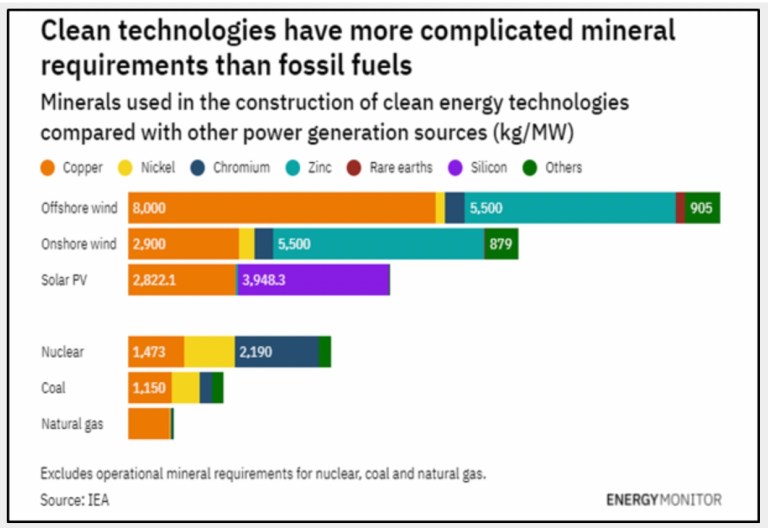Diffuse, intermittent and unreliable wind and solar are utterly pointless as power sources – because they can’t deliver power as and when we need it. However, as a source of insatiable demand for the Planet’s (purportedly) dwindling resources they blitz the field.
At the heart of every Electric Vehicle, solar panel and wind turbine there’s a bevy of rare minerals which are fast becoming rarer, thanks to our ‘inevitable transition’ to an all wind and sun powered future and the much-heralded (and overhyped) shift to all EV motoring.
Donn Dears documents just how un-green wind and solar truly are.
‘Clean’ Energy Dirtier Than Imagined
Power for USA
Donn Dears
4 February 2022
The effect of wind power on birds and bats is already well-publicized but is being swept under the rug.
This article will explain why using wind and PV solar for generating electricity will cause greater harm to the environment than will using nuclear, natural gas combined cycle (NGCC), or coal-fired power plants.
The following chart, published by EnrgyPostEU, compares critical materials used by six different methods for generating electricity.
However, this chart is woefully misleading because it seriously understates the amount of critical materials used by wind and PV solar compared with nuclear, coal or natural gas combined cycle power plants.
According to the chart, the total materials used in kg/MW are as follows:
- Offshore wind 15,000
- Onshore wind 9,200
- Solar PV 6,800
- Nuclear 5,200
- Coal 2,100
- Natural gas combined cycle 1,200
This would seem to show how much critical material is used for wind and solar when compared with nuclear, coal, and natural gas.
It infers that offshore wind, for example, only uses 3 times the amount of critical materials than a nuclear power plant.
However, the values are kg /MW of installed capacity and not for materials used per MW of electricity produced, i.e., kg/MWh.
It also doesn’t reflect the operational life of these six alternatives.
This begs the question:
What is a fair comparison of critical materials used by these different types of power plants to generate the same amounts of electricity?
To answer that question we can look at the materials used when comparing (1) the amount of electricity produced and (2) the operating lives of these different types of power plants.
1, Critical materials consumed based on the quantity of electricity produced:
The capacity factors (CF) for each type of generation are shown here.
- Onshore wind 35%
- Offshore wind 52%
- Solar 25%
- Nuclear 92%
- Natural gas combined cycle 56%
- Coal 54%
(This data is for 2020 from the Energy Information Administration (EIA) , except offshore wind is from the International Energy Agency (IEA).)
CF reflects the amount of electricity actually produced by a power plant. So, for example, a nuclear power plant will generate about twice as much electricity per MW as will an offshore wind turbine.
From this data the critical materials required to generate electricity in kg/MWh is as follows.
Specifically, in kg/MWh:
- Offshore wind 28,900
- Onshore wind 26,300
- Solar 27,200
- Nuclear 5,650
- NGCC 2,140
- Coal 3,890
2. Quantities of material used based on plant lifetimes.
Onshore wind and PV solar have expected lifetimes of around 20 years. Offshore wind installations may also have expected lifetimes of 20 years, though, at this point, no one knows their life expectancy. For example, how well will they hold up against hurricanes?
Nuclear power plants operate for 80 years, while NGCC power plants operate for at least 40 years and coal-fired power plants operate for 60 years.
Therefore, wind and solar plants have to be built and then replaced three times while the nuclear plant is built just once.
Here are the quantities of critical materials consumed in kg/MWh over the life of a nuclear power plant:
- Offshore wind 4 * 28,800 = 115,600
- Onshore wind 4 * 26,300 = 105,200
- PV solar 4 * 27,200 = 108,800
- Nuclear 5,700
In other words offshore wind, and onshore wind and solar require approximately 19 times more critical materials than does nuclear power.
Here are the quantities of critical materials consumed in kg/MWh over the 40 year life of a natural gas combined cycle (NGCC) power plant:
- Offshore wind 2 * 28,900 = 57,800
- Onshore wind 2 * 26,300 = 52,600
- PV solar 2 * 27,200 = 54,400
- NGCC 2,140
In other words offshore wind, and onshore wind and solar require approximately 25 times more critical materials than does a natural gas combined cycle power plant.
Similar calculations can be made for coal-fired power plants.
Conclusion
Wind and solar consume far more critical materials than nuclear, NGCC, and coal-fired power plants.
The mining, processing, and transporting of critical materials adversely affect the environment.
Most of these materials are mined in developing countries where environmental harm will be far worse because they have fewer environmental regulations than do developed countries.
Therefore, nuclear, NGCC, and coal-fired power plants will do substantially less damage to the environment than will the use of wind and PV solar.
One could rightly say nuclear, NGCC, and coal-fired power plants are more sustainable than wind and solar.
The new book, Net-zero Carbon, The Climate Policy Destroying America, explains how the use of wind and PV solar forces the United States to become dependent on China and remote developing countries for critical materials.
Power for USA




Reblogged this on O Pica-Miolos.
Adam Schiff made the problem infinitely worse by making it impossible for Donald Trump to say “The United States opposes the admission of Ukraine and Georgia to NATO.” And Biden couldn’t say it either because Schiff would abuse him too.
Schiff needs to resign, and maybe be tried for treason.
Mike Shellenberger asked several years ago “Must we destroy the environment to save the planet?”